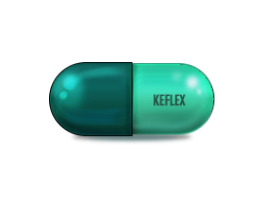Buy Keflex Online

Keflex (Cephalexin) is a semi-synthetic antibiotic of the first generation. It acts bactericidal, that is, it is designed to destroy microbes in the body by inhibiting the synthesis of bacterial cell walls.
Indications for use
The antibiotic Keflex is indicated for infectious processes caused by microorganisms sensitive to this antibiotic:
- For otorhinolaryngological infections (pharyngitis, otitis media, sinusitis, angina);
- Infection of the lower respiratory tract (bronchitis, pneumonia, empyema, lung abscess);
- For infections of the genitourinary system (pyelonephritis, cystitis, urethritis, prostatitis);
- For skin and soft tissue infections (furunculosis, abscess, pyoderma, phlegmon);
- For infections of bones and joints (arthritis, osteomyelitis).
Contraindications
The drug Keflex is not used:
- If you are allergic to cephalosporins as well as penicillins, carbapenems;
- Intolerance to active / auxiliary components;
- With porphyria;
- For infection of the brain/spinal cord.
Use during pregnancy and lactation
It is allowed to use the drug Keflex during pregnancy when prescribed by a doctor. At the time of treatment cease breastfeeding.
Dosage and administration
The dosage is determined by the doctor individually, taking into account localization of infection the severity, the data of the bacteriological studies, susceptibility.
The standard dose for adults and children over 12 years of age is 250-500 mg every 6 or 12 hours. The average daily dose is 1 g, the maximum — 4 g.
The standard course is 7-14 days.
Overdose
Symptoms: nausea, dizziness, epigastric pain, vomiting, diarrhea, hemorrhagic syndrome, electrolyte imbalance, hematuria, hyperreflexia, encephalopathy, convulsions.
Recommended gastric lavage, the use of sorbents, respiratory support, symptomatic therapy.
Side effect
Digestive disorders: decreased appetite, anorexia, nausea, diarrhea, vomiting, abdominal cramps/pain, dry mouth, flatulence, dyspepsia, gastritis, colitis, pseudomembranous enterocolitis, dysbacteriosis, intestinal candidamycosis, candidiasis stomatitis, anal itching.
Hepatobiliary disorders: transient increase in the activity of liver transaminases (AST, ALT), alkaline phosphatase, bilirubin in the blood, cholestatic jaundice, toxic hepatitis.
Hematological disorders: leukopenia, thrombocytopenia/thrombocytosis, neutropenia, agranulocytosis, eosinophilia, lymphopenia, increased prothrombin time, hemolytic anemia, pancytopenia, aplastic anemia, hemorrhages.
Immune disorders: allergic reactions, including angioedema, anaphylactic shock (shortness of breath, bronchospasm, drop in blood pressure, loss of consciousness), drug fever.
Dermatological disorders: erythematous rash, dermatitis, itching, urticaria, skin hyperemia, edema (face, neck, hands, feet), Stevens-Johnson syndrome, erythema multiforme, toxic epidermal necrolysis.
Neurological disorders: dizziness, headache, weakness, agitation, hallucinations, confusion, possible convulsive seizures.
Urogenital disorders: kidney dysfunction, toxic nephropathy, interstitial nephritis, pyuria, reversible fever, hypercreatininemia, eosinophiluria, acute tubular necrosis.
Musculoskeletal disorders: joint damage, arthritis, arthralgia.
Reproductive disorders: genital candidiasis, vaginitis, itching of the genitals, vaginal discharge.
Others: fatigue, false-positive Coombs reaction, result in a urine test for sugar.
Storage terms and conditions
Store Keflex for no more than two years at a temperature of +25°C.
